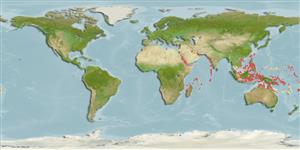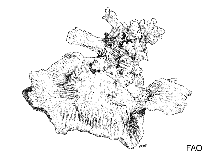Favites acuticollis (Ortmann, 1889)
| Native range | All suitable habitat | Point map | Year 2050 |

|
| This map was computer-generated and has not yet been reviewed. |
| Favites acuticollis AquaMaps Data sources: GBIF OBIS |
Google image | No image available for this species;
drawing shows typical species in Merulinidae.
Classification / Names Populärnamn | synonymer | CoL | ITIS | WoRMS
Hexacorallia | Scleractinia | Merulinidae
Environment: milieu / climate zone / djupintervall / distribution range Ekologi
Revassocierade; djupintervall 0 - 20 m (Ref. 98471). Tropical
Distribution Länder | FAO områden | Ekosystem | Förekomster | Utplanteringar
Northwest and Western Central Pacific: Hong Kong, Malaysia and Indonesia.
Length at first maturity / Size / Weight / Age
Könsmognad: Lm ? range ? - ? cm
Short description Morfologi
Life cycle and mating behavior Könsmognad | Reproduktion | Lek | Eggs | Fecundity | Larvae
Main reference
referenser | Koordinator | Medarbetare
Wijsman-Best, M. 1976 Biological results of the Snellius Expedition XXVII, Faviidae collected by the Snellius Expedition. II. The genera Favites, Goniastrea, Platygyra, Oulophyllia, Leptoria, Hydnophora and Caulastrea. Zoologische Medelingen 50(4):45-63. (Ref. 83538)
IUCN Red List Status
(Ref. 130435: Version 2025-1)
CITES status (Ref. 108899)
CMS (Ref. 116361)
Threat to humans
Human uses
| FishSource |
Verktyg
Ytterligare information
Födosammansättning
Födointag
Predatorer
Max. ages / sizes
Length-weight rel.
Length-length rel.
Length-frequencies
Mass conversion
Abundans
Internet-källor
BHL | BOLD Systems | CISTI | DiscoverLife | FAO(Publication : search) | Fishipedia | GenBank (genome, nucleotide) | GloBI | Gomexsi | Google Books | Google Scholar | Google | PubMed | Tree of Life | Wikipedia (Go, sök) | Zoological Record



